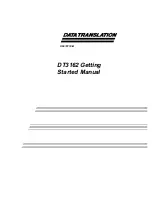
2
SCSI Card 2906 User’s Reference
SCSI IDs
You must assign a unique SCSI ID number from 0 to 7 to the SCSI
Card 2906 and to each SCSI device attached to the SCSI Card 2906. A
SCSI ID uniquely identifies each device on the SCSI bus and deter-
mines priority when two or more devices are trying to use the SCSI
bus at the same time.
Refer to the device’s documentation to set the SCSI ID. Here are
some general guidelines for SCSI IDs:
■
For internal SCSI devices, you generally set the SCSI ID by con-
figuring a jumper on the SCSI device.
■
For external SCSI devices, you generally set the SCSI ID with a
switch on the back of the device.
■
SCSI ID 7 has the highest priority on the SCSI bus. The priority
of the remaining IDs, in descending order, is 6 to 0.
■
Adaptec presets the SCSI Card 2906 to SCSI ID 7, giving it the
highest priority on the SCSI bus. You should not change this
setting.
■
Use SCSI ID 0 for the first SCSI hard disk drive. Most internal
SCSI hard disk drives come from the factory set to SCSI ID 0.
■
In Windows
®
95/98, you can use the Device Manager to view
the SCSI ID (and other details) assigned to each SCSI device
installed, as well as the SCSI card.
SCAM Protocol
The SCSI Card 2906 supports the SCSI Configured AutoMatically
(SCAM) protocol. This protocol assigns SCSI IDs dynamically and
resolves SCSI ID conflicts automatically when you start the com-
puter. If your computer includes SCSI disk drives or other SCSI
devices that support SCAM, you do not need to assign SCSI IDs
manually to these devices. To enable SCAM support, see Configuring
the SCSI Card 2906 with SCSISelect
on page 15.
Note:
To determine if your SCSI device supports the SCAM
protocol, check the SCSI device’s documentation.
Summary of Contents for AVA-2906
Page 1: ...USER S REFERENCE SCSI CARD 2906 ...
Page 3: ...R AVA 2906 SCSI Card 2906 User s Reference ...
Page 4: ......
Page 28: ......
Page 36: ... ...
Page 37: ......
Page 38: ......









































